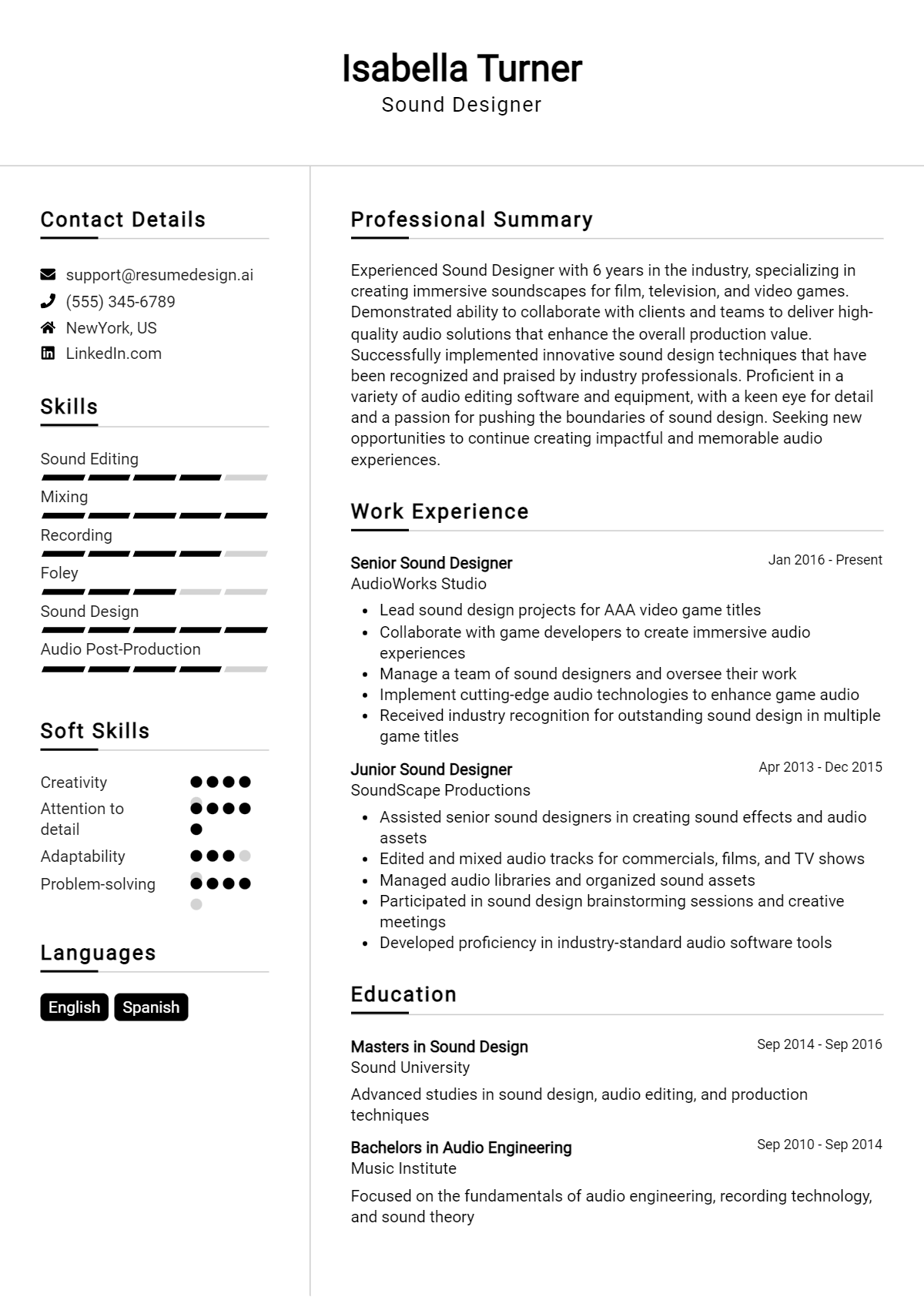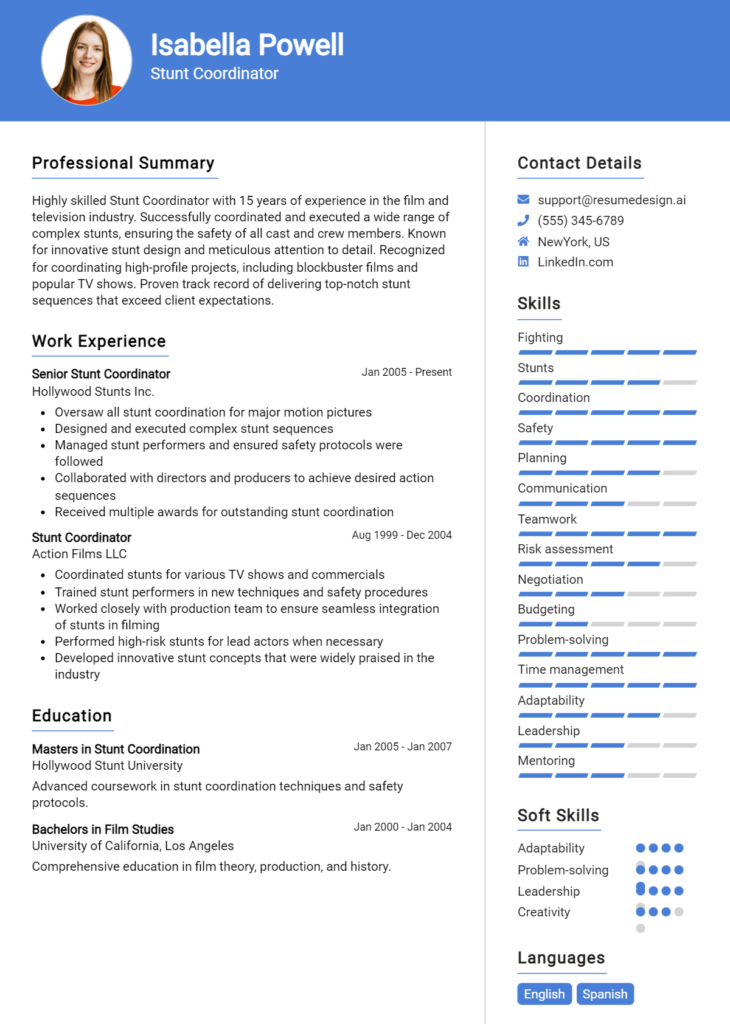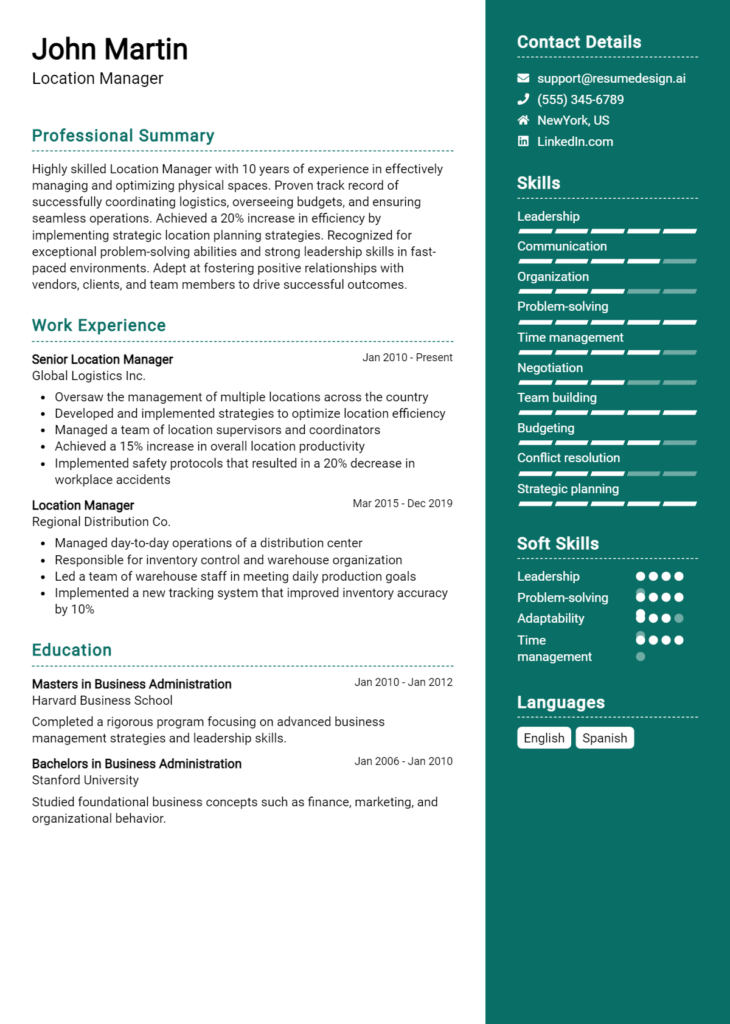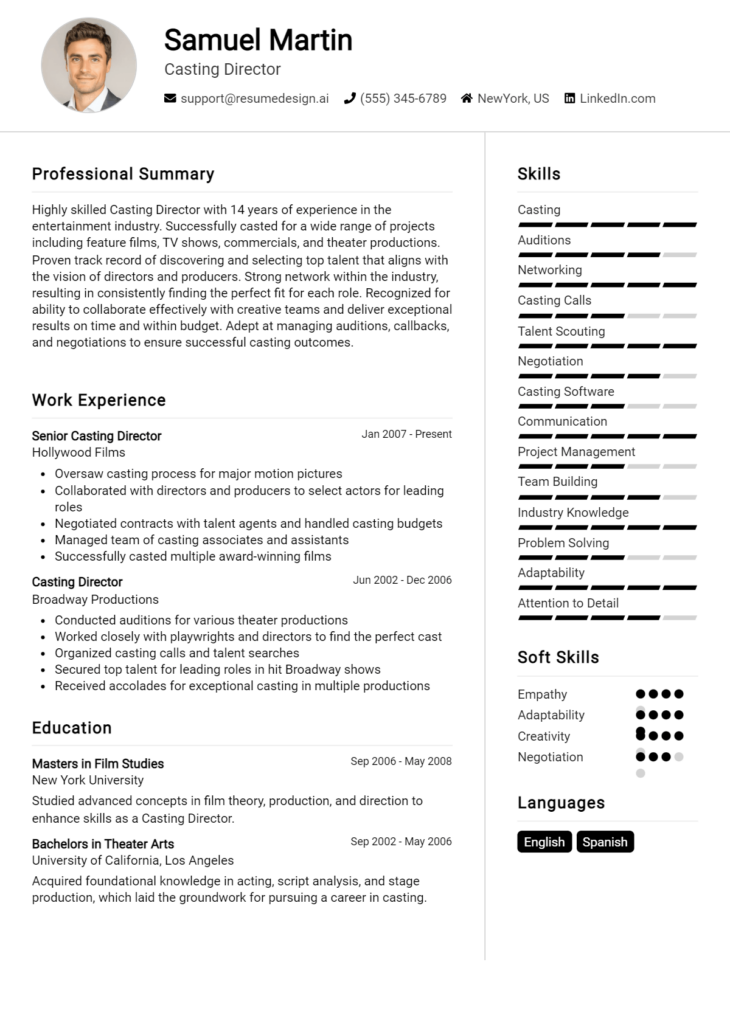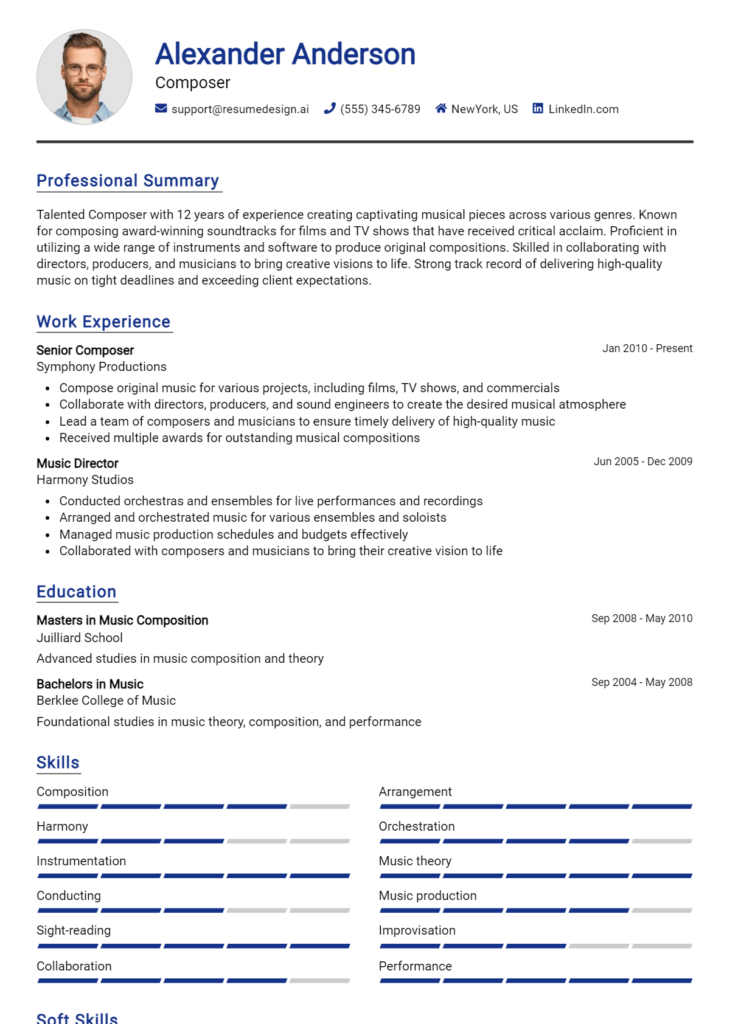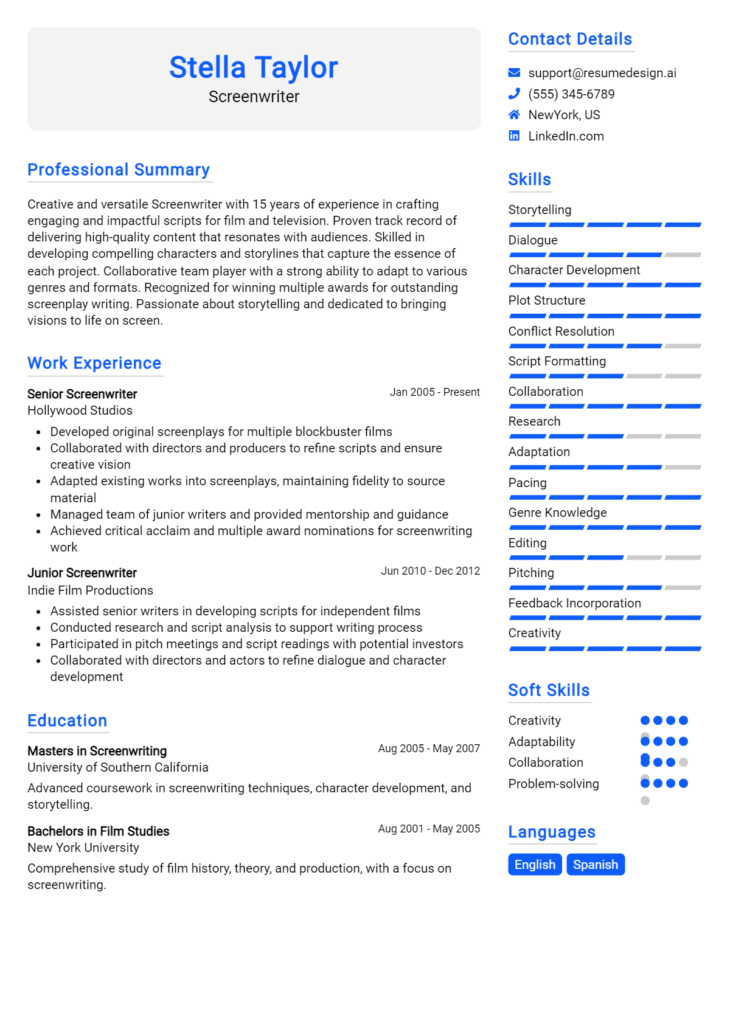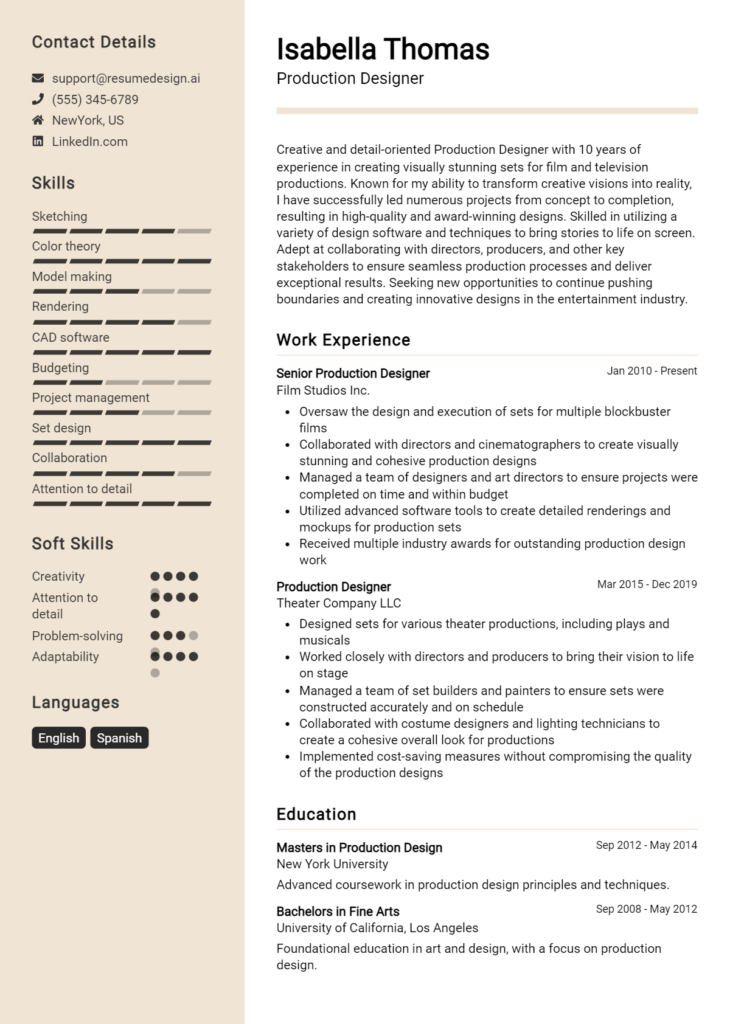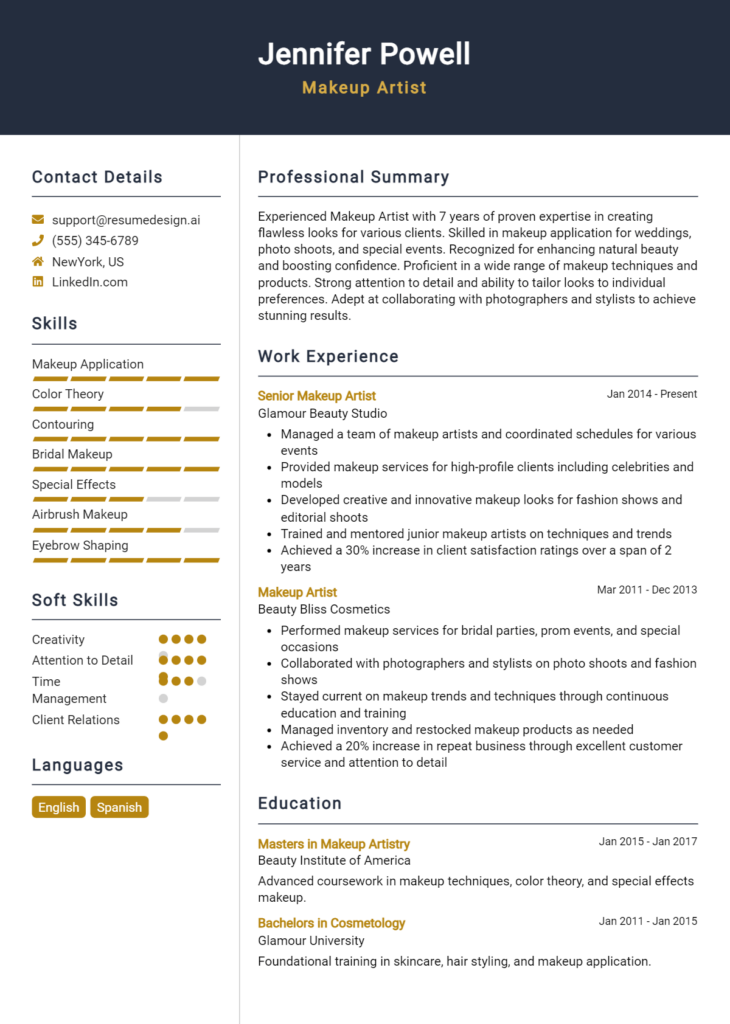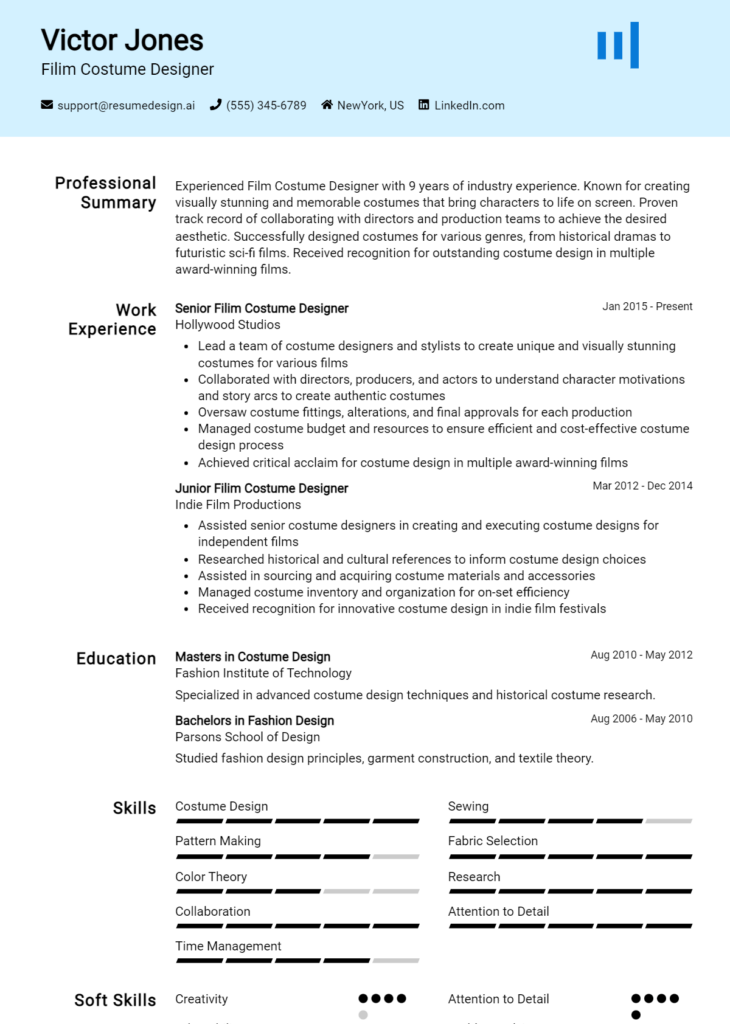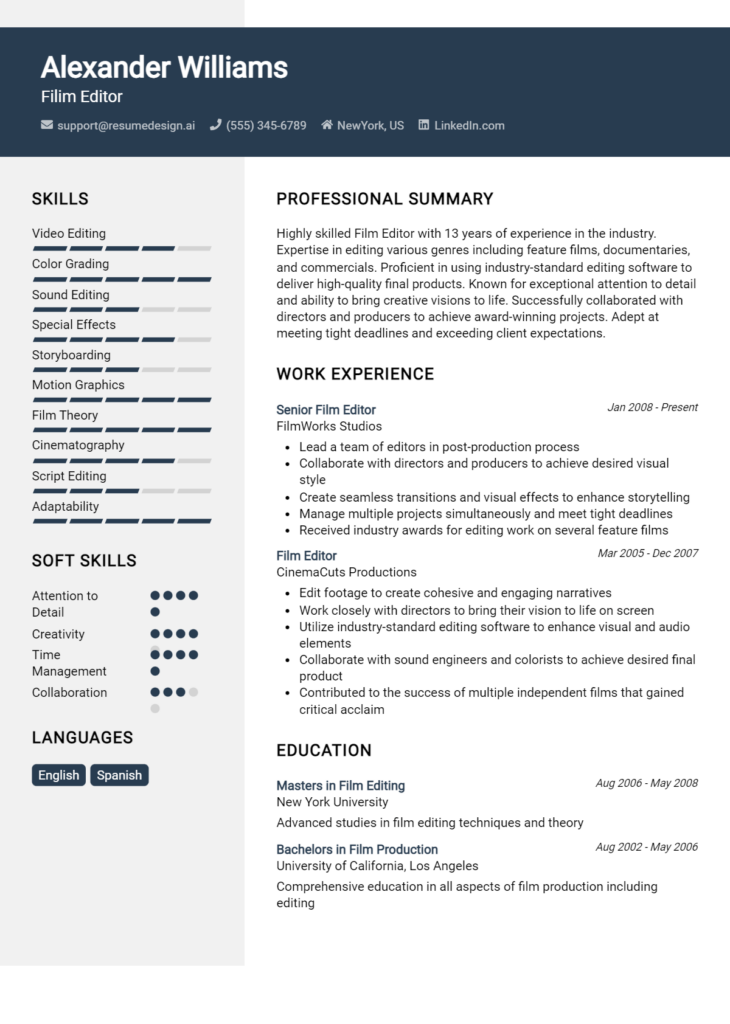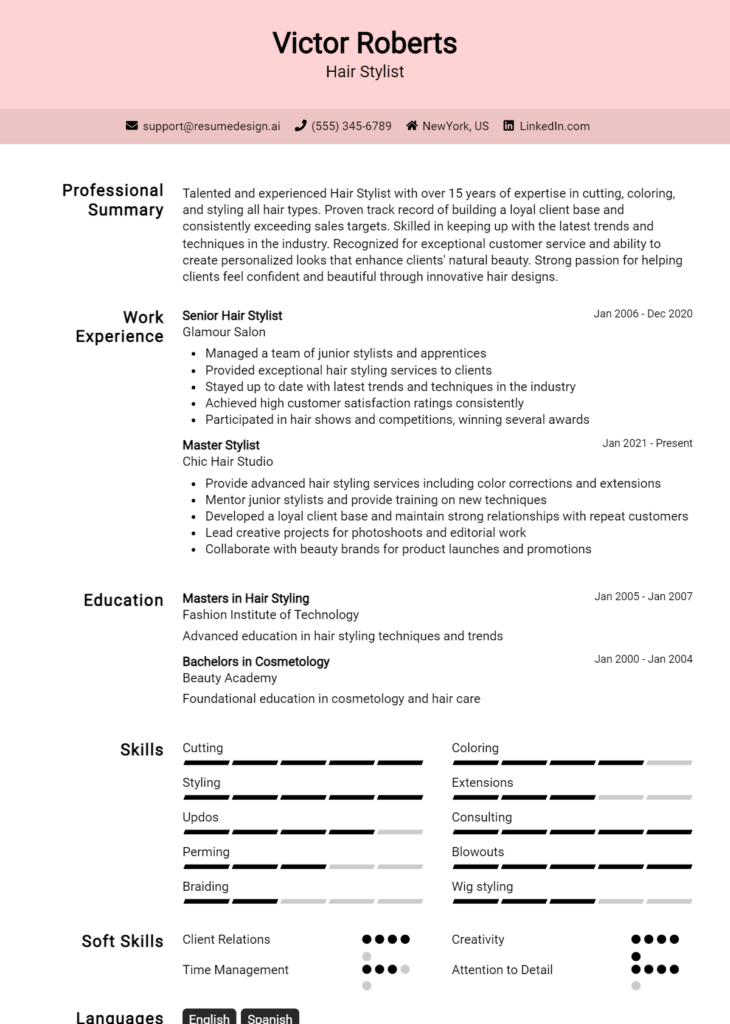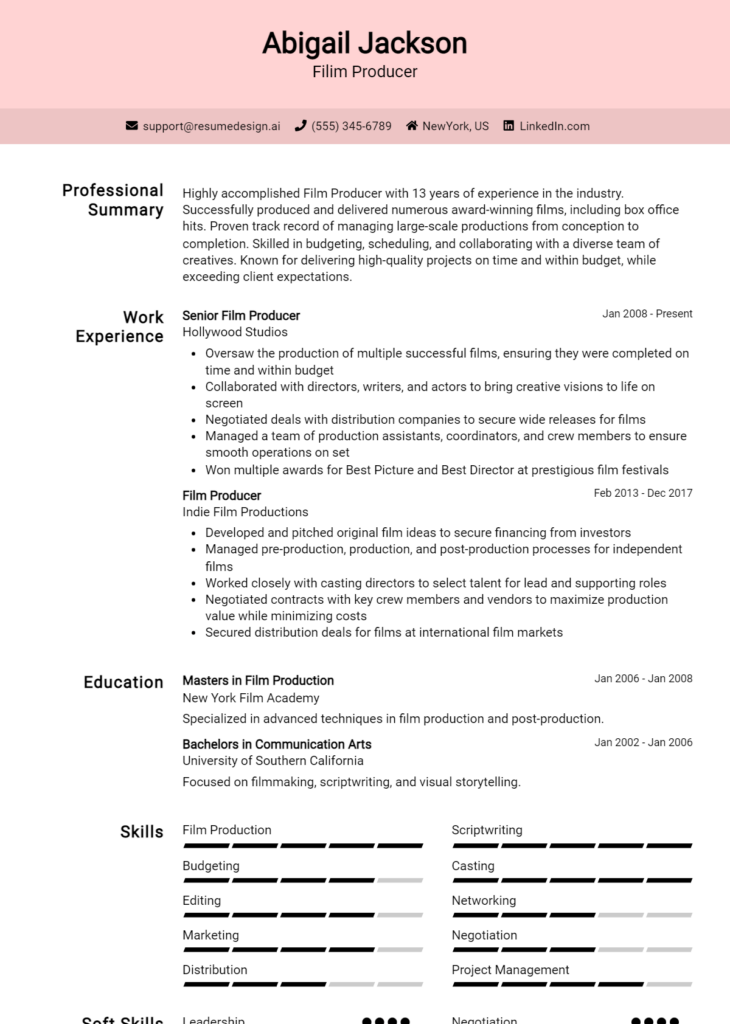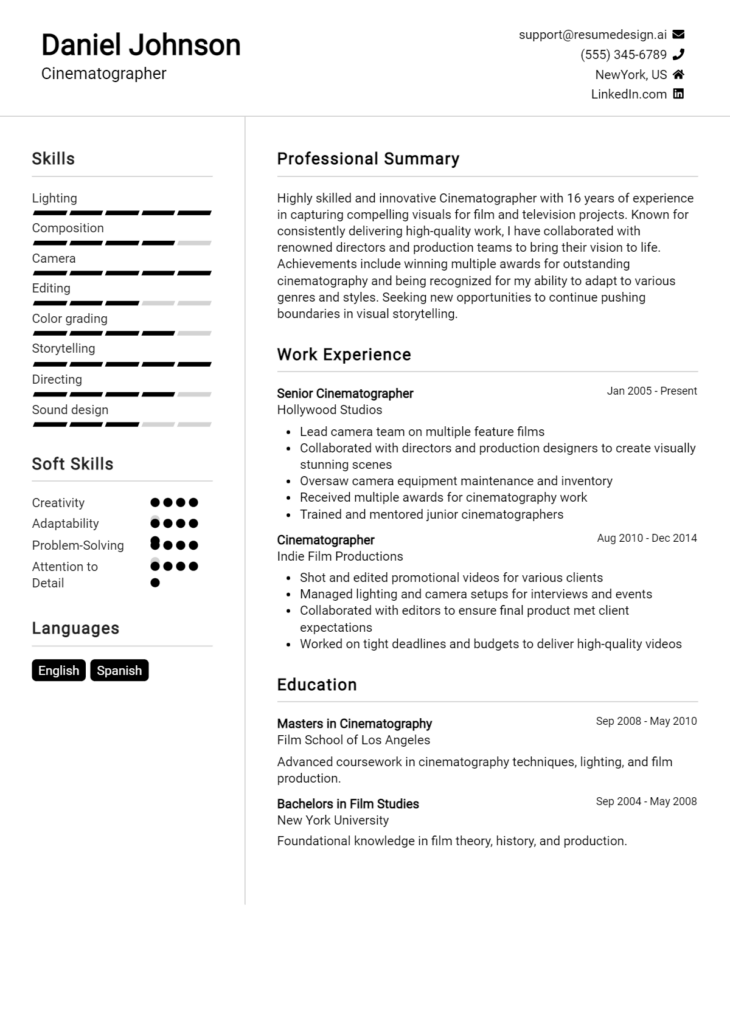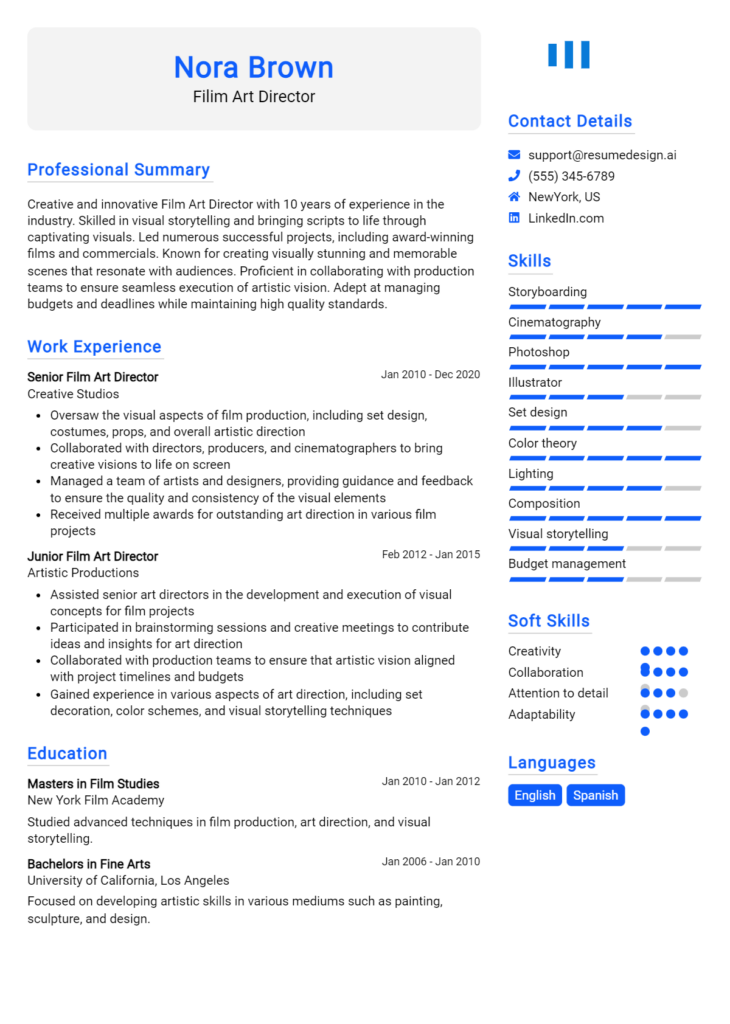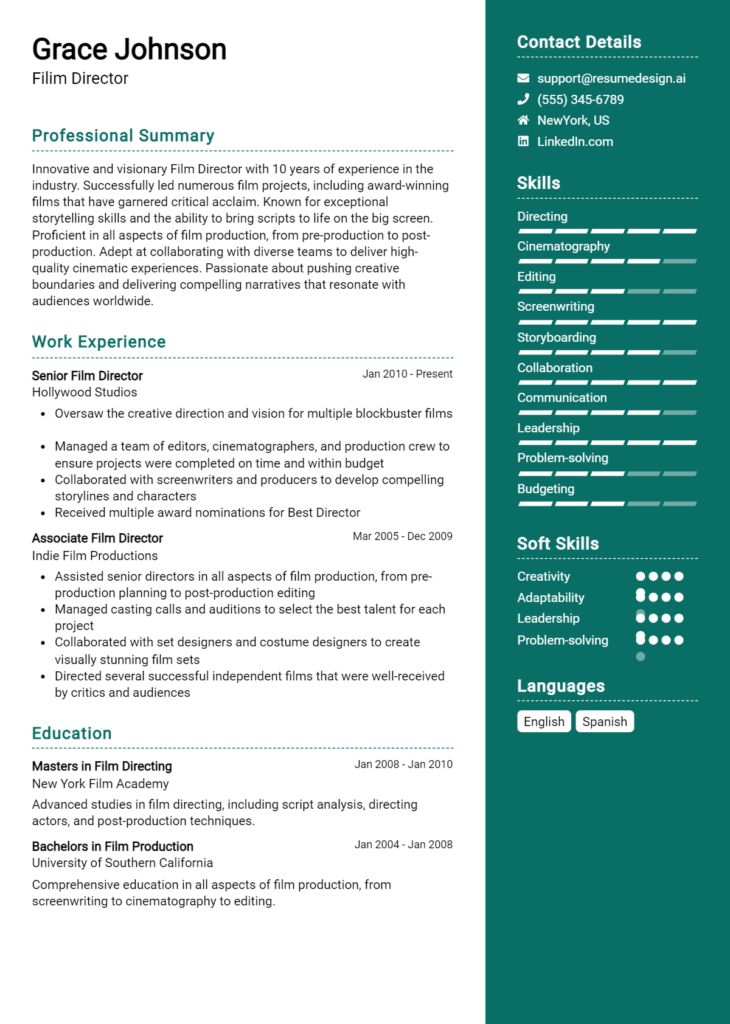Sound Designer Core Responsibilities
A Sound Designer plays a pivotal role in creating the auditory experience for various media, collaborating closely with directors, producers, and editors. They are responsible for designing, recording, and mixing sound effects and music, requiring strong technical skills in audio software and hardware. Problem-solving abilities are essential for troubleshooting sound issues and ensuring high-quality output. A well-crafted resume that highlights these competencies can significantly enhance a candidate's prospects, aligning their expertise with the organization’s creative goals.
Common Responsibilities Listed on Sound Designer Resume
- Design and create sound effects for film, television, and video games.
- Record and edit voiceovers and dialogue tracks.
- Collaborate with directors and producers to develop audio concepts.
- Mix and balance sound elements to achieve desired audio quality.
- Implement sound designs into multimedia projects.
- Conduct audio post-production tasks, ensuring clarity and coherence.
- Maintain and operate audio equipment and software.
- Stay updated on audio technology trends and techniques.
- Provide creative input during brainstorming sessions.
- Conduct sound tests and troubleshoot audio issues.
- Manage project timelines and budgets related to sound production.
- Ensure compliance with copyright and licensing regulations.
High-Level Resume Tips for Sound Designer Professionals
In the competitive field of sound design, a well-crafted resume serves as a crucial tool that can make or break a candidate's chances of landing their dream job. As the first impression potential employers have of you, your resume needs to effectively showcase your unique skills, creative achievements, and passion for audio artistry. It should not only detail your technical expertise but also reflect your ability to contribute to innovative sound projects. In this guide, we will provide practical and actionable resume tips specifically tailored for Sound Designer professionals, helping you to refine your resume into a powerful marketing tool that captures the attention of hiring managers.
Top Resume Tips for Sound Designer Professionals
- Tailor your resume for each job application by aligning your skills and experiences with the specific requirements outlined in the job description.
- Highlight relevant experience prominently, including internships, freelance projects, and collaborations, to demonstrate your hands-on expertise in sound design.
- Quantify your achievements where possible, such as stating the number of projects completed or any awards received to showcase your impact in previous roles.
- Include a dedicated section for technical skills, listing software and tools you are proficient in (e.g., Pro Tools, Logic Pro, Ableton Live) that are relevant to sound design.
- Utilize strong action verbs in your job descriptions to convey your contributions effectively (e.g., “designed,” “created,” “engineered”).
- Incorporate links to your portfolio, demos, or relevant online work to provide tangible evidence of your abilities and creativity.
- Emphasize any experience with different mediums, such as film, video games, or live events, to showcase versatility in sound design.
- Keep your resume clean and organized, using clear headings and bullet points that make it easy for hiring managers to skim through your qualifications.
- Consider adding a brief summary at the top of your resume that encapsulates your career objectives and key strengths in sound design.
By implementing these tips, you can significantly enhance your chances of landing a position in the Sound Designer field. A polished and targeted resume not only showcases your talents but also communicates your dedication to the craft, making you a compelling candidate in the eyes of potential employers.
Why Resume Headlines & Titles are Important for Sound Designer
In the competitive landscape of the audio production industry, a Sound Designer's resume must stand out to capture the attention of hiring managers. Resume headlines and titles are critical components that offer a snapshot of a candidate's qualifications at a glance. A strong headline can immediately engage the reader, summarizing essential skills, experiences, or achievements in a succinct and impactful manner. It should be concise, relevant, and tailored to the specific job being applied for, ensuring that the candidate’s unique value proposition is communicated effectively right from the start.
Best Practices for Crafting Resume Headlines for Sound Designer
- Keep it concise: Aim for a headline that is brief and to the point, ideally one sentence.
- Be role-specific: Tailor your headline to reflect the specific Sound Designer position you are applying for.
- Highlight key skills: Incorporate relevant skills that align with the job description, such as sound editing, mixing, or sound effects creation.
- Use impactful language: Choose strong, action-oriented words that convey your expertise and achievements.
- Include years of experience: If applicable, mention your experience level to establish credibility.
- Make it unique: Differentiate yourself by highlighting what sets you apart from other candidates.
- Reflect your style: Ensure that your headline aligns with your personal brand and the type of work you want to pursue.
- Avoid buzzwords: Steer clear of clichés and generic terms that may dilute the impact of your headline.
Example Resume Headlines for Sound Designer
Strong Resume Headlines
Award-Winning Sound Designer with 10+ Years of Experience in Film and Video Game Audio
Creative Sound Designer Specializing in Immersive Audio Experiences and 3D Soundscapes
Expert Sound Editor and Mixer with Proven Track Record in Enhancing Narrative Through Sound
Weak Resume Headlines
Sound Designer
Audio Professional Looking for Opportunities
The strong headlines are effective because they provide specific information about the candidate's expertise, years of experience, and unique skills that are relevant to the Sound Designer role. They immediately communicate the candidate's value to potential employers, making it easier for hiring managers to see how they fit into the organization. Conversely, the weak headlines fail to impress because they lack detail and specificity, making it difficult for recruiters to discern the candidate's strengths or relevance to the position. Using generic titles can cause a candidate to blend into the sea of applicants, thereby reducing their chances of standing out during the hiring process.
Writing an Exceptional Sound Designer Resume Summary
A well-crafted resume summary for a Sound Designer is crucial for making a strong first impression on hiring managers. In a competitive industry where creativity and technical skills are paramount, a powerful summary acts as a compelling introduction that succinctly showcases a candidate's key skills, relevant experience, and notable accomplishments. This section should be concise yet impactful, tailored specifically to the job being applied for, allowing hiring managers to quickly grasp the candidate's qualifications and fit for the role.
Best Practices for Writing a Sound Designer Resume Summary
- Quantify Achievements: Include specific metrics and outcomes to demonstrate your impact, such as the number of projects completed or audience engagement levels.
- Focus on Relevant Skills: Highlight technical skills, software proficiency, and creative talents that align with the job description.
- Tailor the Summary: Customize the summary for each job application to reflect the specific requirements and desired qualifications outlined in the job posting.
- Be Concise: Keep the summary short, ideally between 3-5 sentences, to maintain the reader's attention.
- Use Action Verbs: Start sentences with dynamic action verbs to convey energy and proactivity in your work.
- Showcase Collaboration: Emphasize your ability to work with directors, producers, and other team members to create cohesive soundscapes.
- Highlight Awards or Recognition: Mention any awards, nominations, or notable projects that can enhance your credibility.
- Include Industry-Specific Terminology: Use relevant jargon and terminology that resonates with hiring managers in the sound design field.
Example Sound Designer Resume Summaries
Strong Resume Summaries
Creative Sound Designer with over 5 years of experience in film and video game audio production, successfully completing 15+ projects that enhanced audience immersion by 30%. Proficient in Pro Tools and Logic Pro, with a strong ability to collaborate effectively with directors to realize their vision.
Detail-oriented Sound Designer skilled in creating innovative soundscapes for immersive storytelling in both broadcast and live environments. Recognized for achieving a 25% increase in viewer engagement through expertly crafted sound design for award-winning documentaries.
Dynamic Sound Designer with a passion for experimental audio techniques and a proven track record of improving project delivery times by 20%. Experienced in managing sound design for multiple high-profile projects, ensuring quality and originality in every production.
Weak Resume Summaries
Sound Designer with experience in audio production. Looking for a new opportunity to use my skills.
Creative professional interested in sound design. I have worked on various projects and want to contribute to a team.
The examples provided illustrate the stark contrast between strong and weak resume summaries. Strong summaries effectively highlight specific skills, quantifiable achievements, and relevant experiences that align closely with the job role, showcasing the candidate's value. In contrast, weak summaries lack detail, specificity, and measurable outcomes, failing to capture the interest of hiring managers and missing opportunities to demonstrate the candidate's qualifications and potential contributions to the team.
Work Experience Section for Sound Designer Resume
The work experience section of a Sound Designer resume is essential as it provides a comprehensive overview of the candidate's professional history, showcasing their technical skills, leadership capabilities, and the quality of their contributions to various projects. This section not only highlights an applicant's proficiency with sound design software and techniques but also illustrates their ability to manage teams and collaborate effectively to deliver high-quality audio products. By quantifying achievements and aligning their experiences with industry standards, candidates can demonstrate their impact in previous roles, making them more attractive to potential employers.
Best Practices for Sound Designer Work Experience
- Highlight specific sound design software and tools you are proficient in, such as Pro Tools, Logic Pro, or Ableton Live.
- Quantify achievements by including metrics, such as the number of projects completed, increased listener engagement, or sound quality improvements.
- Showcase leadership experiences by detailing team management roles, mentorship, or collaborative projects.
- Include a variety of project types, such as film, video games, or live performances, to illustrate versatility.
- Use action verbs to describe your responsibilities and contributions, emphasizing proactivity and results.
- Align your experiences with industry standards by mentioning relevant certifications or industry best practices.
- Provide context for your roles by describing the scale and scope of the projects you worked on.
- Tailor your work experience to the job description, emphasizing the most relevant experiences for the position applied for.
Example Work Experiences for Sound Designer
Strong Experiences
- Led a team of 5 sound designers to create immersive audio experiences for a AAA video game, resulting in a 30% increase in player engagement.
- Developed and implemented a new sound mixing technique that improved audio clarity in films, leading to a 15% rise in positive reviews from critics.
- Collaborated with directors and producers on over 20 projects, ensuring sound design aligned with creative vision and enhancing audience impact.
- Managed the sound design for a live concert series, achieving an audience satisfaction rating of 95% based on post-event surveys.
Weak Experiences
- Worked on various sound projects.
- Helped with sound design for some media productions.
- Assisted in mixing audio for different events.
- Participated in team meetings about sound design.
The examples categorized as strong experiences demonstrate clear achievements, such as quantifiable metrics and specific leadership roles, highlighting the candidate's impact and expertise. In contrast, the weak experiences are vague and lack detail, providing little insight into the candidate's actual contributions or skills, which can make them less compelling to potential employers.
Education and Certifications Section for Sound Designer Resume
The education and certifications section of a Sound Designer resume is crucial as it showcases the candidate's academic background, industry-relevant certifications, and commitment to continuous learning. This section not only underscores the formal education that equips candidates with essential skills in sound design, audio technology, and multimedia production but also highlights any specialized training that enhances their expertise. By providing relevant coursework, certifications, and ongoing educational efforts, candidates can significantly boost their credibility and demonstrate their alignment with the specific requirements of the job role.
Best Practices for Sound Designer Education and Certifications
- Include only relevant degrees and certifications related to sound design, audio engineering, or related fields.
- Detail specific coursework that directly applies to sound design, such as digital audio production, sound design for film, or acoustic principles.
- Highlight industry-recognized certifications, such as Avid Pro Tools certification or Apple Certified Pro in Logic Pro.
- List any specialized training or workshops that focus on emerging sound design technologies or techniques.
- Use clear and concise language to describe your educational achievements and certifications.
- Arrange the educational background in reverse chronological order, starting with the most recent qualifications.
- Consider including relevant extracurricular activities, such as participation in sound design competitions or projects.
- Ensure that all certifications are current and reflect ongoing professional development.
Example Education and Certifications for Sound Designer
Strong Examples
- Bachelor of Arts in Sound Design, University of California, Los Angeles (UCLA), 2021
- Avid Certified Pro Tools User, 2022
- Coursework in Advanced Sound Design and Audio Production, Berklee College of Music
- Certificate in Game Audio Design, Full Sail University, 2023
Weak Examples
- Associate Degree in General Studies, Community College, 2018
- Online Course in Basic Computer Skills, 2020
- Certificate of Completion in Audio Mixing from an unrecognized provider, 2019
- High School Diploma, Graduated 2015
The strong examples are considered effective as they directly relate to sound design and demonstrate relevant skills and knowledge that employers seek. They feature degrees and certifications from recognized institutions and highlight specific coursework that aligns with industry standards. On the other hand, the weak examples lack relevance to the sound design field, showcasing general studies and outdated certifications that do not enhance the candidate's qualifications for a sound designer role.
Top Skills & Keywords for Sound Designer Resume
As a Sound Designer, the ability to convey emotion and atmosphere through audio is paramount. Crafting a compelling resume is essential to showcase not only your relevant work experience but also the skills that set you apart in a competitive field. A well-structured resume highlights both hard and soft skills, demonstrating your technical proficiency and your ability to collaborate effectively within teams. Employers look for candidates who bring creativity, technical knowledge, and strong interpersonal abilities to the table. By emphasizing your skills, you can make a lasting impression and increase your chances of landing the desired position in sound design.
Top Hard & Soft Skills for Sound Designer
Soft Skills
- Creativity
- Communication
- Teamwork
- Problem-solving
- Attention to Detail
- Adaptability
- Time Management
- Critical Thinking
- Collaboration
- Project Management
- Listening Skills
- Patience
- Open-mindedness
- Emotional Intelligence
- Flexibility
- Initiative
Hard Skills
- Audio Editing Software (e.g., Pro Tools, Logic Pro)
- Sound Mixing and Mastering
- Field Recording Techniques
- Foley Artistry
- Sound Synthesis
- Sound Design for Film and Video Games
- MIDI Programming
- Acoustic Treatment Knowledge
- Digital Signal Processing (DSP)
- Music Theory
- Voiceover Recording Techniques
- Audio Restoration
- Noise Reduction Techniques
- Mixing Consoles Operation
- Sound Libraries Management
- Technical Troubleshooting
For a comprehensive overview of skills and how to effectively present your work experience, consider tailoring your resume to highlight these essential competencies.
Stand Out with a Winning Sound Designer Cover Letter
Dear [Hiring Manager's Name],
I am writing to express my enthusiasm for the Sound Designer position at [Company Name], as advertised on [Job Board/Company Website]. With a robust background in audio production and a keen ear for detail, I have honed my skills in creating immersive soundscapes that elevate storytelling across various media. I am excited about the possibility of contributing my expertise to your team, where innovative sound design plays a pivotal role in the overall experience of your projects.
Throughout my career, I have collaborated with diverse teams on a range of projects, from film and video games to advertising and podcasts. My experience includes working with industry-standard software such as Pro Tools, Logic Pro, and Ableton Live, allowing me to craft high-quality audio that enhances engagement and emotional resonance. I pride myself on my ability to understand and interpret the creative vision of directors and producers, translating their ideas into compelling auditory experiences that captivate audiences. Notably, my recent project on [specific project name or type], received recognition for its unique use of sound, showcasing my commitment to innovation and excellence.
I am particularly drawn to [Company Name] because of your reputation for pushing the boundaries of creativity and technology in audio design. I admire your recent work on [specific project or title], which demonstrated a remarkable synergy between sound and visuals. I am eager to bring my unique perspective and skill set to your team, contributing to projects that not only meet but exceed audience expectations. I believe that my passion for sound design, coupled with my technical proficiency and collaborative spirit, would make me a valuable asset to your creative endeavors.
Thank you for considering my application. I look forward to the opportunity to discuss how I can contribute to the exciting work being done at [Company Name]. Please feel free to contact me at [Your Phone Number] or [Your Email Address] to schedule a conversation. I am excited about the possibility of bringing my sound design expertise to your esteemed team.
Warm regards,
[Your Name]
[Your LinkedIn Profile or Portfolio Link]
[Your Phone Number]
[Your Email Address]
Common Mistakes to Avoid in a Sound Designer Resume
When crafting a resume for a Sound Designer position, it's essential to present your skills and experiences effectively. Common mistakes can detract from your qualifications and make it harder for hiring managers to see your potential. Avoiding these pitfalls will help ensure your resume stands out in a competitive field. Here are some common mistakes to steer clear of:
Generic Objective Statements: Using a one-size-fits-all objective fails to convey your specific passion for sound design and may appear insincere. Tailor your objective to the company and role you're applying for.
Neglecting Technical Skills: Sound design relies heavily on technical proficiency with software and equipment. Omitting specific tools (like Pro Tools, Logic Pro, or Adobe Audition) can make your resume less compelling.
Overloading with Jargon: While industry terminology is important, overusing jargon can alienate readers. Strive for clarity and ensure that your resume is accessible to both technical and non-technical recruiters.
Lack of Portfolio Links: Sound design is a visual and auditory field. Failing to include links to your portfolio or samples of your work can prevent hiring managers from assessing your talents effectively.
Ignoring Relevant Experience: Some sound designers may overlook related experiences in music production, audio editing, or even volunteer work. Highlight all relevant experiences to demonstrate your versatile skill set.
Formatting Issues: A cluttered or poorly formatted resume can distract from your qualifications. Use clear headings, bullet points, and consistent fonts to ensure easy readability.
Failing to Quantify Achievements: Providing concrete metrics (like project budgets, audience sizes, or software proficiency) can make your accomplishments more impactful. Use numbers to illustrate your contributions wherever possible.
Typos and Errors: Spelling mistakes or grammatical errors can undermine your professionalism. Always proofread your resume and consider having someone else review it for clarity and accuracy.
Conclusion
As a Sound Designer, your role is crucial in creating immersive audio experiences that enhance storytelling in various media, including film, television, and video games. Throughout this article, we explored the essential skills and qualifications needed for this dynamic position, such as proficiency in audio editing software, a strong understanding of acoustics, and creative sound manipulation techniques. We also discussed the importance of having a diverse portfolio that showcases your unique soundscapes and projects.
In conclusion, it’s imperative to ensure your resume reflects your skills and experiences effectively. A well-crafted resume not only highlights your technical abilities but also your creative flair as a Sound Designer. Take the time to review your resume and consider how it aligns with the expectations of potential employers in the industry.
If you’re looking to enhance your resume, there are various tools available to assist you. Explore our resume templates for inspiration on layout and design, or utilize our resume builder for a more guided approach to creating your document. For additional ideas, check out our collection of resume examples tailored for Sound Designers. Don’t forget the power of a compelling introduction—our cover letter templates can help you make a strong first impression.
Now is the time to refine your Sound Designer resume and stand out in the competitive job market. Take action today!

